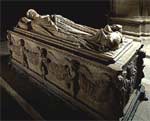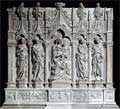Jacopo di Pietro D'Agnolo di Guarnieri, known as Jacopo della Quercia, was born in Querciegrossa near Siena some time between  1371 and 1375. Little is known about his training but he was influenced by the late gothic tradition of the great Pisano.
1371 and 1375. Little is known about his training but he was influenced by the late gothic tradition of the great Pisano.
The earliest work known to be his is the Madonna on the throne with Child in the duomo of Ferrara.
There is no doubt his most famouswork is the Tomb of Ilaria del Carretto, in the sacristy of the duomo of Lucca, commissioned by Paul Giunigi, lord of Lucca, perhaps in 1423.
The tomb depicts the deceased lying on an ark shaped as a parallelepipedon decorated with cherubs and ornaments; the head is delicately resting on a pillow and a dog, symbolising her husband’s faithful love, lies at her feet. The Monument is clearly a phase of transition between late gothic trends and Renaissance trends: the lady’s clothes, with accurately painted cloth, are in medieval style whereas the very realistic face shows a tendency towards Renaissance style.
In about 1408 Jacopo della Quercia received a commission for Fonte Gaia (a fountain) in piazza Del Campo in Siena; it was finished in 1419 and the only surviving parts are currently in the upper balcony of Palazzo Pubblico.
 Between 1413 and 1422 he received a commission for the Altar of the Trenta family in St Frediano in Lucca. It is shaped as a Polyptich: the upper part, with gothic shapes, is made up of 5 compartments with scultures of the Madonna with Child, with the Saints Jerome, Richard, Ursula and Lawrence at the sides. The predellas with the Stories of Saints have a more natural style.
Between 1413 and 1422 he received a commission for the Altar of the Trenta family in St Frediano in Lucca. It is shaped as a Polyptich: the upper part, with gothic shapes, is made up of 5 compartments with scultures of the Madonna with Child, with the Saints Jerome, Richard, Ursula and Lawrence at the sides. The predellas with the Stories of Saints have a more natural style.
The artist’s masterpiece is the decoration of the main door of St Petronius in Bologna, commissioned in 1425. The pillars’ tiles show stories from the book of Genesis; there is a Madonna with Child in the upper lunette, Stories from the Gospel on the architrave. There are strong Renaissance elements, both in the shapes and in the composition; the ‘stiacciato’ technique is used to achieve depth.
In Bologna the artist executed the Bentivoglio Monument, in the church of St James and the Tryptic with the Madonna and Saints, in the Civic museum.
Jacopo della Quercia died in 1438.